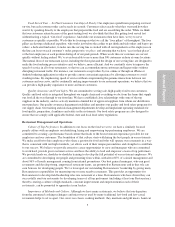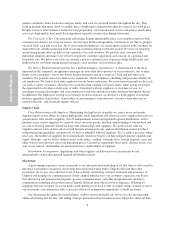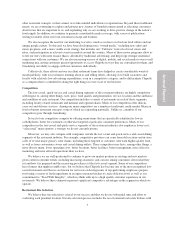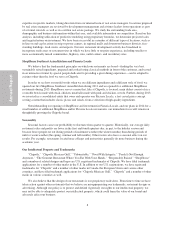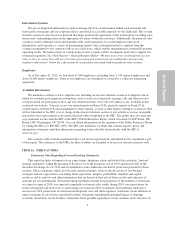Chipotle 2013 Annual Report Download - page 17
Download and view the complete annual report
Please find page 17 of the 2013 Chipotle annual report below. You can navigate through the pages in the report by either clicking on the pages listed below, or by using the keyword search tool below to find specific information within the annual report.
the District of Columbia and U.S. Securities and Exchange Commission of our compliance with work
authorization requirements and related disclosures and statements are ongoing. See Note 9 “Commitments and
Contingencies” in our consolidated financial statements included in Item 8. “Financial Statements and
Supplementary Data.” Termination of a significant number of employees in specific markets or across our
company would disrupt our operations including slowing our throughput, and could also cause additional adverse
publicity and temporary increases in our labor costs as we train new employees. We could also become subject to
fines, penalties and other costs related to claims that we did not fully comply with all recordkeeping obligations
of federal and state immigration compliance laws. Our financial performance may be materially harmed as a
result of any of these factors.
Because we do not franchise, risks associated with hiring and maintaining a large workforce, including
increases in wage rates or the cost of employee benefits, compliance with laws and regulations related to the
hiring, payment and termination of employees, and employee-related litigation, may be more pronounced for us
than for restaurant companies at which some or all of these risks are borne by franchisees or other operating
contractors.
Instances of food-borne or localized illnesses could cause the temporary closure of some restaurants or
result in negative publicity, thereby resulting in a decline in our sales, and could adversely affect the price and
availability of the meat, produce or dairy we use to prepare our food.
Instances of food-borne illnesses, real or perceived, whether at our restaurants or those of our competitors,
may subject us to liability to affected customers, and could result in negative publicity about us or the restaurant
industry that adversely affects our sales. For instance, on a small number of occasions a Chipotle restaurant has
been associated with customer illness, and on those occasions our sales have been adversely impacted, at times
even in markets beyond those impacted by the illness. We may be at a higher risk for food-borne illness
outbreaks than some competitors due to our use of fresh produce and meats rather than frozen, and our reliance
on employees cooking with traditional methods rather than automation. If our customers become ill from food-
borne or localized illnesses or if an illness is attributed to our food, even incorrectly, we could also be forced to
temporarily close some restaurants. In addition, reports linking nationwide or regional outbreaks of food-borne
illnesses have caused us to temporarily suspend serving some produce items in our foods or to otherwise alter our
menu. Similarly, past outbreaks of E. coli relating to certain food items caused consumers to avoid certain
products and restaurant chains, Asian and European countries have experienced outbreaks of avian flu, and
incidents of “mad cow” disease have occurred in Canadian and U.S. cattle herds. These problems, other food-
borne illnesses (such as hepatitis A or norovirus) and injuries caused by food tampering have had in the past, and
could have in the future, an adverse affect on the price and availability of affected ingredients. A decrease in
customer traffic as a result of these health concerns or negative publicity, or as a result of a change in our menu
or dining experience or a temporary closure of any of our restaurants, would adversely impact our restaurant
sales and profitability. Furthermore, if we react to these problems by changing our menu or other key aspects of
the Chipotle experience, we may lose customers who do not accept those changes, and may not be able to attract
enough new customers to generate sufficient revenue to make our restaurants profitable. Customers may also
shift away from us if we choose to pass along to consumers any higher ingredient costs resulting from supply
problems associated with outbreaks of food-borne illnesses, which would also have a negative impact on our
sales and profitability. The risk of illnesses associated with our food might increase in connection with an
expansion of our catering business or other situations in which our food is served in conditions we cannot
control.
Competition could adversely affect us.
The fast-casual, quick-service and casual dining segments of the restaurant industry are highly competitive
with respect to, among other things, taste, price, food quality and presentation, service, location and the ambience
and condition of each restaurant. Our competition includes a variety of restaurants in each of these segments,
including locally owned restaurants and national and regional chains. Many of our competitors offer dine-in,
carry-out and delivery services. Many of our competitors have existed longer than we have and may have a more
established market presence with substantially greater financial, marketing, personnel and other resources than
15
Annual Report


